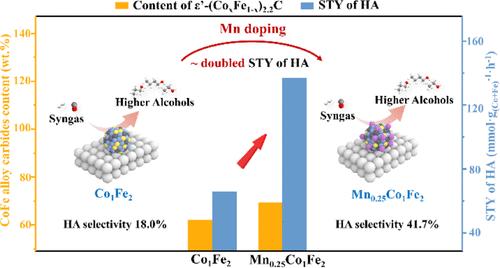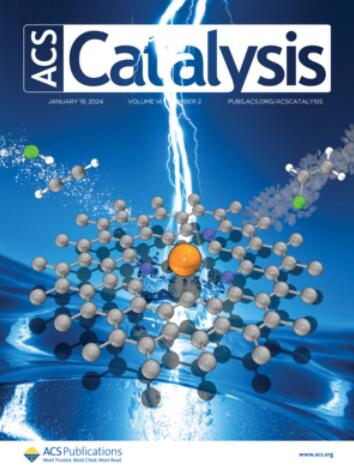Selective C2+ Alcohol Synthesis from Syngas Boosted by MnOx-Doped CoFe Bimetallic Alloy Carbide Catalysts
IF 11.3
1区 化学
Q1 CHEMISTRY, PHYSICAL
引用次数: 0
Abstract
Direct synthesis of higher alcohols (HA) from syngas is an attractive route for converting nonpetroleum carbon feedstocks into high value-added fuels and chemical products. CoFe alloy carbide catalysts are promising for this reaction, but facilitating the alloy carbide formation is still challenging. Herein, a series of Mn-promoted catalysts with regulated proximity between Mn and CoFe2O4 were prepared. It was found that the manganese species with close intimacy greatly facilitated the formation of ε’-(CoxFe1–x)2.2C, reaching a maximum content of 88.4 wt % over the Mn0.25Co1Fe2 catalyst. A space-time yield toward HA of 137.9 mmol·g(Co+Fe)–1·h–1 with stability over 300 h was achieved over this catalyst, ranking top among the literature. In addition, MnOx also greatly promoted the CO dissociation. The closely interacted MnOx and ε’-(CoxFe1–x)2.2C sites benefited the coupling of CHx* and CO*/CHO*, leading to the modification of the Anderson-Schulz–Flory law and the enhanced C2+ alcohols fraction in total alcohols up to 94.1 wt %. Moreover, the Mn content was also optimized. This promotional effect of manganese may provide possibilities for the use of CoFe alloy carbide catalysts in higher alcohol synthesis.

求助全文
约1分钟内获得全文
求助全文
来源期刊

ACS Catalysis
CHEMISTRY, PHYSICAL-
CiteScore
20.80
自引率
6.20%
发文量
1253
审稿时长
1.5 months
期刊介绍:
ACS Catalysis is an esteemed journal that publishes original research in the fields of heterogeneous catalysis, molecular catalysis, and biocatalysis. It offers broad coverage across diverse areas such as life sciences, organometallics and synthesis, photochemistry and electrochemistry, drug discovery and synthesis, materials science, environmental protection, polymer discovery and synthesis, and energy and fuels.
The scope of the journal is to showcase innovative work in various aspects of catalysis. This includes new reactions and novel synthetic approaches utilizing known catalysts, the discovery or modification of new catalysts, elucidation of catalytic mechanisms through cutting-edge investigations, practical enhancements of existing processes, as well as conceptual advances in the field. Contributions to ACS Catalysis can encompass both experimental and theoretical research focused on catalytic molecules, macromolecules, and materials that exhibit catalytic turnover.
 求助内容:
求助内容: 应助结果提醒方式:
应助结果提醒方式:


